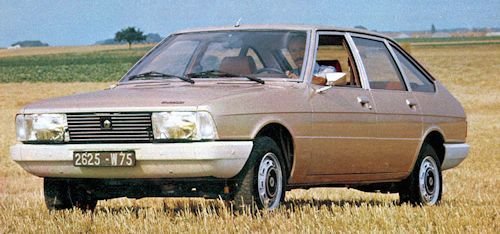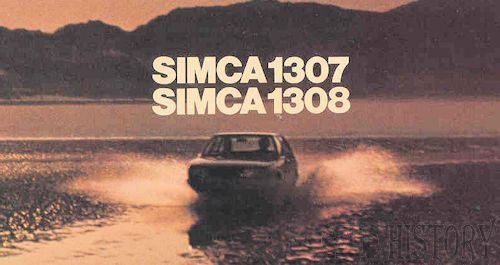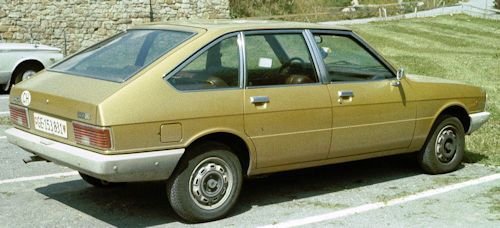Simca 1307 1308 1309
 | |
Manufacturer | Chrysler Europe / PSA |
Production | 1975 to 1986 |
Assembly | Poissy, France Ryton-on-Dunsmore, United Kingdom |
Predecessor | Simca 1301 / 1501 |
Class | Large family car |
Layout | FF layout |
Engine | 1057 1294, 1442 1592 cc ohv straight-4 |
Transmission | 4 speed manual all-synchromesh |
Wheelbase | 102.5 in (2,604 mm) |
Length | 167 in (4,242 mm) |
Width | 66 in (1,676 mm) |
Curb weight | 2,314 lb (1,050 kg) |
Designer | Roy Axe |
The Simca 1307 was the name under which Chrysler Europe a large family car in built from July 1975 untill 1986.
History
The "1307" project began in 1969 under the code name "Chrysler B-Car", which was intended to replace the old models of the Simca 1301 / 1501 range from the 1960s, derived from the Simca 1300 / 1500 of the Fiat era. The specifications required that this new range have engines whose displacement had to be between 1,500 and 1,800 cm 3. This required the design of a new gearbox to handle the greater torque of the new engines which were to have one or two overhead camshafts. It was therefore not possible to use the base of the old engines which were still valid but had a side camshaft.
Several sketches were presented at the beginning of 1970 with a classic 3-volume body and only one in a two-volume version with tailgate. It is this drawing which will be selected for the creation of a plaster model a few months later, despite the reluctance of Chrysler's American management. The commercial success of the Renault 16, Auto Bianchi Primula and Simca 1100 was enough to convince Chrysler Europe to continue with this solution. However, in July 1970, when Chrysler became the exclusive owner of the Poissy brand, the managers made a clean sweep of all current projects and required starting everything from scratch at the beginning of 1971 with a new project called "C6 or A+Car”, where "A+" means a vehicle type below the previous "B-Car". The new specifications have maintained the hatchback formula in order to make the use of the car more practical. Concerning the other elements, it was decided that the useful interior volume would be increased and the car would be front-wheel drive with the engine placed transversely at the front.
The design of the bodywork was entrusted to the styling centre in Whitley, England, headed by Roy Axe. The line was totally innovative for the brand and stood out radically from the Chrysler 160/180 models. The final design was chosen on May 21, 1973.Regarding mechanics, Chrysler management refused the study of new overhead camshaft engines, which flourished on all Italian cars and imposed the old technique of side cam engines, derived from those used on the 1100. This is how the old 1.3 Liter type 366 engine will be modified to give birth to the 1,442 cm 3 version. The gearbox from the 1100 was reused without modification. The front axle of the 1100 has been adapted for the new model, while the rear will receive swinging arms.

The final development was carried out by the Centro de Carrières-sous-Poissy, where the first 13 prototypes were assembled. Testing began on June 28, 1974and ended on February 11, 1975in Lapland. Three pre-series of 355 examples were manufactured in the spring of 1975.
By July 5, 1975, Chrysler Europe issues a press release announcing the official launch of a new model. The 1307/1308 range was made official two weeks later. The presentation of the new range of models took place from September 1 to October 4, 1975. The presentation to the public takes place on September 27 during the Paris Motor Show of the two models: the Simca 1307 and the high-end version, the 1308.
After the first oil crisis of 1973, the era was no longer one of fantasy. Customers are looking for simple, robust, practical and fuel-efficient cars. The best examples of the era are the Fiat 131 and Volkswagen Passat which meet expectations well. Intended to replace the Simca 1301/1501, they enjoyed a certain success thanks to their body incorporating a tailgate despite serious corrosion problems, like many cars of the time. The three designations have a single common body, only the engines and the level of equipment/finish differentiate them; the last figure initially signalled the fiscal power. It was the Chrysler France study centre in Carrières-sous-Poissy which carried out the industrial development of these vehicles. The Chrysler Europe style activities being grouped in Whitley in England under the direction of Roy Axe.
The Simca 1307 was named Car of the Year for 1976. This is the first French car designed in computer CAD. The Simca 1307/1308 range was extended under the Talbot brand with the 1510 and Solara models (notchback version). It was marketed in Great Britain under the name Chrysler Alpine and in Spain under the name Chrysler 150.
A modern, front-wheel drive hatchback, it was one of the first such cars in that class, along with the Volkswagen Passat, and became the 1976 European Car of the Year. It had been in development since 1972.The model was sold under a variety of names, including Simca 1308 and 1309 models (with larger engines), Chrysler Alpine (name used for the Irish, UK and New Zealand markets), Chrysler 150 (Spanish market), Talbot 1510 / Talbot Alpine / Talbot 150 (a facelifted version launched by PSA after its takeover of Chrysler Europe) and Talbot Solara (the saloon version).
More upmarket models were designated 1308 (1508 in some markets) and 1309. All of the models replaced the Simca 1301/1501 range in France, while on the British market it was sold alongside the aging Hillman Hunter.
Styled by Roy Axe, the Simca 1307, along with the recently introduced Volkswagen Passat, was one of several full-size European family hatchbacks inspired by the Renault 16 that had defined the sector back in 1965. In the 1970s the most popular mid-size cars in Europe were still traditional sedans like Ford Taunus, Ford Cortina, Opel Ascona (Vauxhall Cavalier) and Peugeot 305. The car was originally manufactured in Poissy in France, in Ryton in the United Kingdom, from 1977 in Villaverde in Barreiros, subsidiary of Chrysler Europe in Spain, and assembled from CKD kits by Todd Motors (later Mitsubishi Motors NZ) in New Zealand between 1977 and about 1983. Between 1979 and 1985 the car was also built by Valmet Automotive in Uusikaupunki factory in Finland and assembled in Colombia as Dodge Alpine between 1978 and 1982 at the Chrysler Colmotores in Bogotá.
In 1980 the car, which was now sold under the Talbot-brand, received a facelift. The new model was known as the Talbot 1510 (the Talbot Alpine name was used in the UK). A saloon version, called the Talbot Solara, was released that year, and produced alongside the hatchback version.

In New Zealand, Chrysler, Talbot, Alpine and 1510 badges were used on the car during its lifetime, though it was officially in price lists as an Alpine, following the UK convention. In 1982 the car was facelifted and renamed SX there.
French manufacturing of 1510, Alpine and Solara, along with the smaller Horizon, ended in 1985. In the United Kingdom the last cars were rebadged as the Rapier and Minx which were badged depending on trim level rather than body style. The names were sourced from the corporate ancestor of Chrysler Europe, the Rootes Group, having been used on the Sunbeam Rapier and Hillman Minx. Supply of these models was limited and in 1986 production ceased, with the Talbot marque being shelved soon afterwards on all passenger vehicles. Due to corrosion problems similar to those of the Horizon few Alpines have survived in the UK; according to the June 2009 issue of Practical Classics, only 15 remain in the country. A body of the Simca 1307 was a direct inspiration for the design of Russian Moskvitch Aleko.

Rating
Technical
-
Simca 1307 08 09 Technical details and specifications (1975-1986)
DIMENSIONS
Length overall - 4245mm. 13ft. 11in
Width overall - 680mm. 66.1 in.
Height overall - 1390mm. 54.7in.
Weight (kerb) - 1075kg. 23701b. or 21-2cwt.
Ground clearance (min.) - 130mm. (5.1 in.)
Track
Front - 1415mm. 55.7m.
Rear - 1390mm. .54.7in.
Wheelbase - 2604mm. 102.5in.)
Turning circle diameter - 10•4m. (34ft 1 in.) to kerbsENGINE: 1442cm
Type 4-stroke; O.H.V. ; push-rods
Cooling system - Water pump, radiator
Number of cylinders - 4 in line (direct in block
Firing order and idling speed - 1-3-4-2 (No. 1 by flywheel)
Bore - 76.7mm.
Stroke - 78mm.
Cubic capacity - 1442cm
Compression ratio - 9.5:1
Carburettor - (Weber 36 DCNV)TRANSMISSION
Type Front-wheel drive; manual gearbox
Clutch (cable op.) - Verto 181.5mm., hydraulic operation
Final drive ratio - 3-588:1 (61/17)
BRAKES (Dual circuit)
Front - ATE, 240 x 11mm. discs
Rear - Bendix or Girling, 228•6mm. (9in.)
Handbrake - Mechanical, on rear wheels drumsSTEERING
Type - Rack and pinion
FRONT SUSPENSION
Type -Torsion bars; anti-roll bar; telescopic shock-absorbersREAR SUSPENSION
Type -Coil springs and trailing arms; anti-roll bar ; telescopic shock-absorbers© Motor car History
-
Simca 1307 08 09 Maintenance (1975-1986)
Servicing intervals - 5000 miles
Engine sump oil 1442cm - 3 litres (5.3 pints) + 0.5.for filter
Gearbox - 0-6 litres
Differential - 0-5 litres
Cooling system - 6.5 litres (11.4 pints)
Fuel tank - 60 litres (13.2 gallons)
Tyre size (standard) - 155SR13
Tyre pressures (lb./in.2) - 1.8bar 26lb in front and rear-Simca 1307 08 09 (1975-1986) Advanced Maintenance is available for members-
© Motor car History



